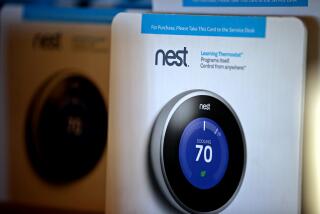Energy-efficient home shoppers should look for Energy Star label
In the 1970s, clothing shoppers were advised in a popular advertising jingle from the International Ladies’ Garment Workers’ Union to “look for the union label.” In that same spirit, anyone shopping for an energy-efficient home today would be well-advised to look for the sky-blue Energy Star label.
No disrespect toward LEED, Energy Performance and GreenPoint, all of which are fine rating systems in their own right, but Energy Star seems to have become most popular among home builders looking to differentiate themselves from the competition. More important, Energy Star provides a way for consumers to compare one home against another.
“Every home we build from coast to coast is a 100% Energy Star-certified home,” says C.R. Herro, vice president of environmental affairs at Meritage Homes, one of the country’s largest builders. Pulte and K.B. Home are other big Energy Star builders.
Energy Star is “the most recognizable and meaningful” of the energy performance labels, says Gene Myers, chief executive of New Town Builders in Denver. “We’ve looked at them all and gave up on all of them except Energy Star. It proves our homes cost less to operate.”
To Rene Oehlerking of Garbett Homes, which builds in Utah, Wyoming and Idaho, Energy Star is “a no-brainer.”
“Consumers can really see the dollars they are saving,” Oehlerking says.
Energy Star is a joint program of the Environmental Protection Agency and the Department of Energy that helps consumers identify energy-efficient products. To earn an Energy Star certification, a new home built today must include features that make it at least 15% more efficient than homes built solely to the 2009 model energy building code, otherwise known as the International Energy Conservation Code.
Pasted to the home’s electrical box, the Energy Star label is loaded with information, including annual usage estimates for electricity, natural gas and carbon dioxide emissions. It also projects the owner’s yearly energy savings. But for most buyers, the key is the HERS rating.
HERS stands for Home Energy Rating System. It has been around since 1995, when a group of mortgage lenders, state energy officials and Energy Rated Homes of America created the Residential Energy Services Network (RESNET). Along with creating HERS, the independent nonprofit network is dedicated to creating a market for home energy ratings and to training independent contractors to rate homes fairly and consistently.
Myers, the Denver builder, compares the HERS rating to the miles-per-gallon sticker on new automobiles. With cars, though, you want a higher number, while with houses, you are better served with a lower number.
The HERS rating system runs from 150 to zero. A home built 20 years ago might earn a 133 rating, whereas a more efficient house built 10 years ago might receive a 123 rating.
The standard new home, built to the 2009 IECC with no special energy features, would rate a 100, says Steve Baden, executive director of the San Diego-based RESNET. The HERS score drops if builders do anything more than what is required in the way of energy efficiency.
Each one-point decrease in the HERS index corresponds to a 1% reduction in energy consumption. Houses with a 72 rating are 28% more efficient than a standard house; a house with a 50 rating would be 50% more efficient; and one with a zero rating would be 100% more efficient.
Myers says his company’s homes are consistently in the 40s, which means they are super-efficient. To see how his homes measure up to the competition, buyers can simply compare New Town’s HERS scores with those of other builders.
“All you have to do,” Myers says, “is say, ‘Show me your HERS score.’”
Unfortunately, not all builders’ homes are rated by a RESNET-trained energy auditor. That’s becoming less of a problem, however. Last year, according to Baden of RESNET, about 40% of all new homes sold carried a HERS rating. “We have gone from certifying a few hundred homes” a decade ago, he says, “to 120,000 in 2011.”
In June, Meritage, the big builder based in Scottsdale, Ariz., built the 1 millionth house rated by a HERS technician. “We use HERS scores because they allow customers to make substantive comparisons in an apple-to-apple way. If you build something better, you need to validate it and then convert it to currency,” says Herro of Meritage.
“We’ve staked our future on HERS,” adds Oehlerking, the marketing director at Garbett Homes. So have members of the Lexington, Ky., home builders association, which last month signed a memorandum of understanding with RESNET committing to encourage every member to participate in the Energy Star program.
All Energy Star homes are now constructed with a complete thermal enclosure system for comfort and lower utility bills, an HVAC system designed and installed for optimal performance and a comprehensive water management system to protect the building envelope from moisture intrusion.
Incidentally, an energy rating is not the same as an energy audit. An audit, or assessment, pinpoints where and how a home loses energy, which systems are working inefficiently and the cost-effective measures that can be taken to improve performance. A rating, on the other hand, provides an analysis on how efficiently a home operates compared with other houses.
Distributed by Universal Uclick for United Feature Syndicate.
More to Read
Sign up for Essential California
The most important California stories and recommendations in your inbox every morning.
You may occasionally receive promotional content from the Los Angeles Times.





